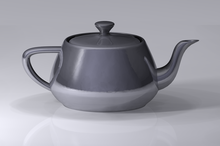

The Utah teapot, or the Newell teapot, is one of the standard reference test models in 3D modeling and an in-joke[1] within the computer graphics community. It is a mathematical model of an ordinary Melitta-brand teapot designed by Lieselotte Kantner that appears solid with a nearly rotationally symmetrical body. Using a teapot model is considered the 3D equivalent of a "Hello, World!" program, a way to create an easy 3D scene with a somewhat complex model acting as the basic geometry for a scene with a light setup. Some programming libraries, such as the OpenGL Utility Toolkit,[2] even have functions dedicated to drawing teapots.
The teapot model was created in 1975 by early computer graphics researcher Martin Newell, a member of the pioneering graphics program at the University of Utah.[3] It was one of the first to be modeled using Bézier curves rather than precisely measured.
- ^ Dunietz, Jesse (February 29, 2016). "The Most Important Object In Computer Graphics History Is This Teapot". Nautilus. Retrieved March 3, 2019.
- ^ Mark Kilgard (February 23, 1996). "11.9 glutSolidTeapot, glutWireTeapot". www.opengl.org. Retrieved October 7, 2011.
- ^ Torrence, Ann (2006). "Martin Newell's original teapot: Copyright restrictions prevent ACM from providing the full text for this work". ACM SIGGRAPH 2006 Teapot on - SIGGRAPH '06. p. 29. doi:10.1145/1180098.1180128. ISBN 978-1-59593-364-5. S2CID 23272447. Article No. 29.